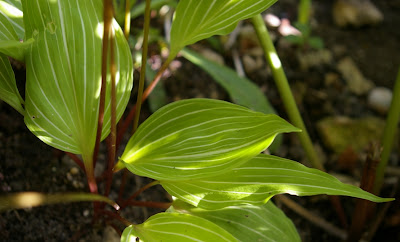 |
| Allium ovalifolium var. leuconeurum |
The plant grows from a narrow bulb and consists of a pair of leaves and a scape bearing a round head of small flowers. The leaves are broad and pointed, borne on distinct petioles, suggesting those of Ramsons (A. ursinum) but without the rank garlic stink. When broken they are, of course, smelly, but the odour reminds me more of a stock cube than an onion outright. Their most interesting feature is the presence of longitudinal white veins, which make them rather handsome; the lamina is light green now, but it emerges with a red flush on which the stripes are particularly conspicuous. The plant's name refers to both the leaf shape (ovalifolium) and the stripes (leuconeurum). According to Flora of China, the variety is found in forests in western Sichuan between 2800-3800 m. There are several broad-leaved Allium species in China, but only this taxon has white-veined leaves.
 |
| Foliage of Allium ovalifolium var. leuconeurum |
The flowers are individually small, but together make up a rounded head about 4 cm in diameter, carried on a long red scape well above the leaves. Although nothing about the flowers is individually showy the combination of red scape, pink pedicels, white petals, yellow anthers and green ovaries is very pretty.
Here it is growing on a sloping bed among other plants: in fact the foliage is under the overhang of an adjacent hellebore but seems none the worse for this shading, suggesting it is well adapted to life on the forest floor. I suspect it would prefer a little more moisture than it gets so I'll split a bulb off as it goes dormant and try it in the humus-rich bed.
 |
| Flower heads of Allium ovalifolium rising above the foliage of Helleborus x hybridus. |








.JPG)
















John - Mark has identified our plants from ACE#94-2394 as ovalifolium v. leuconeurum as well. It was collected at Gang-ho-ba, Lijang, China at 3450m from screes. I think your is much more attractive in flower than the one here. That scree must have had constant moisture as moisture seems to be to its liking. For awhile we thought it might be prattii.
ReplyDeletejohn in coastal NS
It really has got most attractive foliage - for an allium.
ReplyDelete